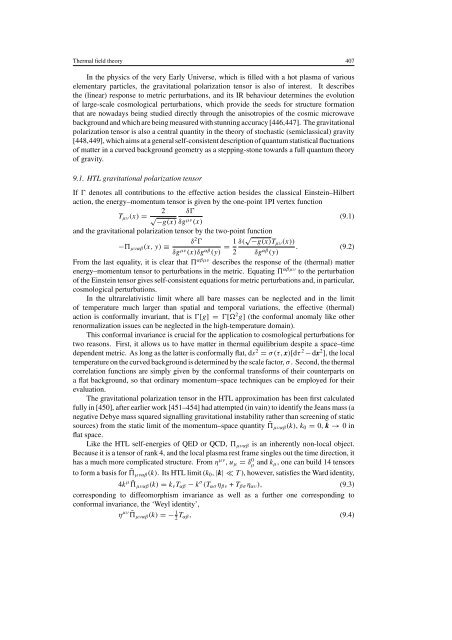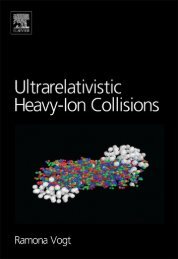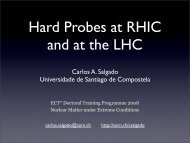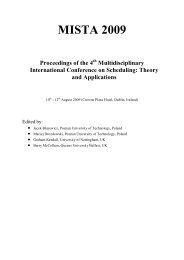Advances in perturbative thermal field theory - Ultra-relativistic ...
Advances in perturbative thermal field theory - Ultra-relativistic ...
Advances in perturbative thermal field theory - Ultra-relativistic ...
Create successful ePaper yourself
Turn your PDF publications into a flip-book with our unique Google optimized e-Paper software.
Thermal <strong>field</strong> <strong>theory</strong> 407<br />
In the physics of the very Early Universe, which is filled with a hot plasma of various<br />
elementary particles, the gravitational polarization tensor is also of <strong>in</strong>terest. It describes<br />
the (l<strong>in</strong>ear) response to metric perturbations, and its IR behaviour determ<strong>in</strong>es the evolution<br />
of large-scale cosmological perturbations, which provide the seeds for structure formation<br />
that are nowadays be<strong>in</strong>g studied directly through the anisotropies of the cosmic microwave<br />
background and which are be<strong>in</strong>g measured with stunn<strong>in</strong>g accuracy [446,447]. The gravitational<br />
polarization tensor is also a central quantity <strong>in</strong> the <strong>theory</strong> of stochastic (semiclassical) gravity<br />
[448,449], which aims at a general self-consistent description of quantum statistical fluctuations<br />
of matter <strong>in</strong> a curved background geometry as a stepp<strong>in</strong>g-stone towards a full quantum <strong>theory</strong><br />
of gravity.<br />
9.1. HTL gravitational polarization tensor<br />
If Ɣ denotes all contributions to the effective action besides the classical E<strong>in</strong>ste<strong>in</strong>–Hilbert<br />
action, the energy–momentum tensor is given by the one-po<strong>in</strong>t 1PI vertex function<br />
2 δƔ<br />
T µν (x) = √ (9.1)<br />
−g(x) δg µν (x)<br />
and the gravitational polarization tensor by the two-po<strong>in</strong>t function<br />
δ 2 Ɣ<br />
− µναβ (x, y) ≡<br />
δg µν (x)δg αβ (y) = 1 δ( √ −g(x)T µν (x))<br />
. (9.2)<br />
2 δg αβ (y)<br />
From the last equality, it is clear that αβµν describes the response of the (<strong>thermal</strong>) matter<br />
energy–momentum tensor to perturbations <strong>in</strong> the metric. Equat<strong>in</strong>g αβµν to the perturbation<br />
of the E<strong>in</strong>ste<strong>in</strong> tensor gives self-consistent equations for metric perturbations and, <strong>in</strong> particular,<br />
cosmological perturbations.<br />
In the ultra<strong>relativistic</strong> limit where all bare masses can be neglected and <strong>in</strong> the limit<br />
of temperature much larger than spatial and temporal variations, the effective (<strong>thermal</strong>)<br />
action is conformally <strong>in</strong>variant, that is Ɣ[g] = Ɣ[ 2 g] (the conformal anomaly like other<br />
renormalization issues can be neglected <strong>in</strong> the high-temperature doma<strong>in</strong>).<br />
This conformal <strong>in</strong>variance is crucial for the application to cosmological perturbations for<br />
two reasons. First, it allows us to have matter <strong>in</strong> <strong>thermal</strong> equilibrium despite a space–time<br />
dependent metric. As long as the latter is conformally flat, ds 2 = σ(τ,x)[dτ 2 −dx 2 ], the local<br />
temperature on the curved background is determ<strong>in</strong>ed by the scale factor, σ . Second, the <strong>thermal</strong><br />
correlation functions are simply given by the conformal transforms of their counterparts on<br />
a flat background, so that ord<strong>in</strong>ary momentum–space techniques can be employed for their<br />
evaluation.<br />
The gravitational polarization tensor <strong>in</strong> the HTL approximation has been first calculated<br />
fully <strong>in</strong> [450], after earlier work [451–454] had attempted (<strong>in</strong> va<strong>in</strong>) to identify the Jeans mass (a<br />
negative Debye mass squared signall<strong>in</strong>g gravitational <strong>in</strong>stability rather than screen<strong>in</strong>g of static<br />
sources) from the static limit of the momentum–space quantity ˜ µναβ (k), k 0 = 0, k → 0<strong>in</strong><br />
flat space.<br />
Like the HTL self-energies of QED or QCD, µναβ is an <strong>in</strong>herently non-local object.<br />
Because it is a tensor of rank 4, and the local plasma rest frame s<strong>in</strong>gles out the time direction, it<br />
has a much more complicated structure. From η µν , u µ = δµ 0 and k µ, one can build 14 tensors<br />
to form a basis for ˜ µναβ (k). Its HTL limit (k 0 , |k| ≪T ), however, satisfies the Ward identity,<br />
4k µ ˜ µναβ (k) = k ν T αβ − k σ (T ασ η βν + T βσ η αν ), (9.3)<br />
correspond<strong>in</strong>g to diffeomorphism <strong>in</strong>variance as well as a further one correspond<strong>in</strong>g to<br />
conformal <strong>in</strong>variance, the ‘Weyl identity’,<br />
η µν ˜ µναβ (k) =− 1 2 T αβ, (9.4)







